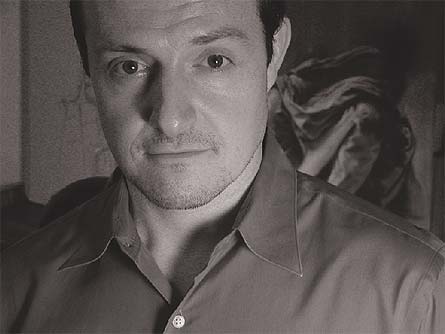George Perros: An eye for beauty
by Katerina Georgiou
A row of steel-bladed gravers in various shapes and sizes are lined in a row on George Perros’ desk. Their mushroom-shaped handles give them a primitive look that belies their use: these are the ancient tools of the hand engraver. Beside the desk, a floral still life propped up on an easel awaits finishing touches but its vibrant colors bring an uplifting atmosphere to the room. One might consider Perros’ active home workspace a metaphor for the mind and soul of a man on a mission to realize his life’s potential through art. And much like the mythic hero in his own drama, he has traveled far from his birthplace—Athens, Greece—to do it.

When he was five, his parents, Antonis and Katerina, moved the family, which included younger brother Nick, to New York. Perros has lived here ever since, making his home in Bayside with wife Katherine, and two young daughters, Ava and Alicia.
The “connection to a wider something” first attracted him to art. “I’ve been putting things down on paper since I was old enough to grab on to something,” he says.
But the pressures of an immigrant upbringing made an artistic career implausible. Instead he opted for the steadier path to academia, obtaining a masters degree in Political Science from St. John’s University. While working towards a second masters at The New School for Social Research, his neighbor, a veteran engraver, approached Perros after admiring his artwork. At the time, he didn’t know a thing about engraving but at his neighbor’s urging Perros apprenticed with him.

Though the earliest known engravings date back to 1446, time and technology have done little to change the craft. Training is still done the old fashioned way: putting pencil to paper to draw lines before carving designs on hard, flat surfaces. The engraver’s job is to communicate thoughts—preserving emotions for all of posterity. It’s fitting then to consider that history’s most famous messenger, Paul Revere, the American Revolution patriot, was an engraver.
Perros breezed through his apprenticeship, completing the yearlong training in four months. The experience marked a turning point in his life—the shift away from academia proved auspicious and almost fifteen years later his engraving career is flourishing.
But cultivating a discerning eye for beauty hasn’t come without rigorous practice.
“Beauty comes up in everything,” he says. “But you must challenge yourself to see it.”
So while working as an engraver he furthered his drawing skills—taking classes at the Art Students League in New York and adding painting to his repertoire. Studying the Renaissance masters, with their ability to make two-dimensional objects come to life, had a deep impression on him.
“Through their drawings—not their paintings—they were able to approach the truth,” he says.
This discovery reshaped his perspective on life: everywhere he looked images presented themselves for interpretation. The possibilities seemed endless. What started as a desire for connectivity had since developed into a tangible skill—something he could rely on to express his sensitivity to the world around him.
 The defining moment occurred on a visit to The Metropolitan Museum of Art, where upon viewing Leonardo da Vinci’s drapery study for a seated figure, he returned home impassioned and spent an exhaustive week reproducing it.
The defining moment occurred on a visit to The Metropolitan Museum of Art, where upon viewing Leonardo da Vinci’s drapery study for a seated figure, he returned home impassioned and spent an exhaustive week reproducing it.
“I wanted to see how light reacts to fabric,” he says. “It’s the same principle that compels you to put flowers on a canvas. On close examination, these seemingly beautiful objects obtain a truth when you really examine them. You see things you didn’t see before,” he says, shining a lamp on his da Vinci reproduction above the desk.
The light illuminates the painting’s rich details: shades of violet, black and white cascade into a sumptuous fabric that appears to weigh down on itself like a waterfall.
“The attempt to understand the real; that’s what art is all about,” he says.
This soul-searching approach also informs his engraving.
“An engraving, like a drawing or painting, tells a story; it approximates the truth,” he says.
To demonstrate, he pulls out a monogrammed cufflink and holds it up to the light.
“Every nuance is there by design,” he says. “The depths of the cuts give an illusion of brightness…it’s the only way to reflect color. With a machine engraving the depth is always the same. That’s why control is an engraver’s most important skill. You have to have a steady hand. There’s no slipping; you have to be very exact.”
For all its painstaking effort, engraving has served him well in life—imparting the patience and discipline he needed to become a better overall artist.
“Engraving taught me that you have enough time to study human anatomy, perspective, color—all these technical aspects of painting and drafting—so you can make something that satisfies you,” he says. “You won’t think twice about technical know-how. You know it’s there.”
His eyes turn to his da Vinci reproduction once again.
“You can spend a whole day downloading songs on your computer but what have you accomplished?” he says. “I’m talking about using your mind to reach your potential. If you give a little bit more effort and sacrifice sleep each night you can create works of beauty.”
Perhaps it’s true that beauty is everywhere. And the search for it can be just as pleasing.